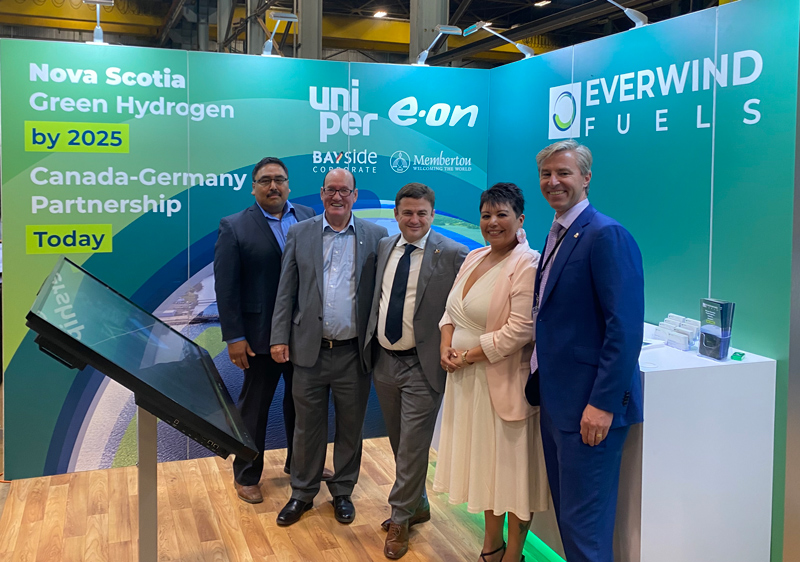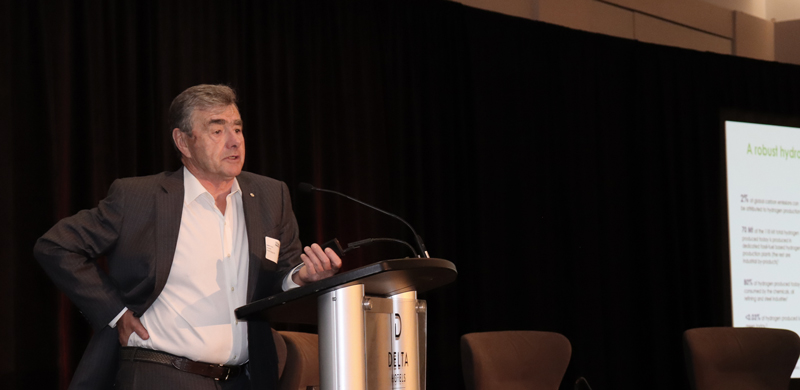Account Login
Don't have an account? Create One

Founder and CEO of EverWind Fuels LLC, Trent Vichie says his company’s plan for a hydrogen facility at Point Tupper, Nova Scotia will prove Nova Scotia and, more broadly, Atlantic Canada’s potential to become a global hydrogen supply hub.
“One thing I know is that political will and support goes away when there’s no tangible results and so, given our site, we’re in a position to deliver probably the first project in Atlantic Canada that’s permitted and under construction,” he recently told Atlantic Business Magazine.
The company’s plan is to see a hydrogen plant with ammonia production for international shipping, developed at the former NuStar Transshipment Terminal at Point Tupper, near Port Hawkesbury. The 1,400-acre property is now controlled by EverWind and has the advantage of being a brownfield site, with existing industrial infrastructure including a two-berth, deepwater port alongside the Strait of Canso.
EverWind has filed a project description for a “Class 1” environment assessment with the Nova Scotia government. There are two classes of project review in the province. Class 1 projects specifically are not expected to cause significant environmental impacts or be of great environmental concern. A Class 1 review will typically take 50 calendar days and can be extended. A Class 2 review, in comparison, would typically be 275 calendar days to complete.
The EverWind development has arguably seen less attention to date than the proposed World Energy GH2 wind-hydro-ammonia development proposed for Western Newfoundland. However, EverWind’s development may be the first in the region to reach hydrogen and ammonia production. Vichie said the company still expects first hydrogen by 2025. He said he’s expecting to start seeing permits in the fourth quarter of this year.
The company is notably putting forward a staged development, with about $1 billion in immediate capital investment. It will see production started and initially achieving 200,000 to 300,000 tonnes of ammonia for export, before growing to about one million tonnes, or what Vichie referred to as global “table stakes,” with potential to grow from there. Expansions over time will include the addition of 2 GW of dedicated wind power capacity.
Power planning
The first phase and first production rely on use of the existing electricity grid in Nova Scotia and purchases of electricity from Nova Scotia Power. The company is talking green hydrogen (‘green,’ as it’s manufactured with renewable power). That will require Nova Scotia to independently press ahead with bringing new renewables onto the grid, including the five wind power projects announced in August in the province’s largest-ever procurement for in-province renewable energy. The projects were selected by RFP, handled by an independent procurement administrator. As the CBC has reported, the wind projects are expected to have an installed capacity of 372 MW and be able to generate about 1,373 gigawatt hours per year of electricity, bringing Nova Scotia’s grid up to about 70 per cent renewable electricity by 2025 (including consistent deliveries of electricity from Newfoundland and Labrador per Muskrat Falls Project-related contracts).
Vichie said the hydrogen facility in Richmond County will be useful to Nova Scotia Power and the province’s larger green power goals, given some flexibility in industrial operations and the ability to facilitate new energy development through purchases. A specific example is offshore wind, with EverWind interested in establishing interconnections and procuring from offshore wind developers to serve its long-term expansion plans, moving beyond one million tonnes of ammonia production and export. The company’s marine terminal could become a multi-user port and Point Tupper home to links from offshore to the onshore grid.
“We’ve been very clear with people that we welcome that (offshore wind supply) and we want to support that activity,” he said, specifically describing wind development for energy exports. “Because that’s a big activity for Nova Scotia and the Atlantic region, but it’s important for Canada and it’s also important for energy security, for our European allies as well.”
The company has already made an investment into the nearby Allan J. MacRachen Regional Airport, coming on as a financial partner, supporting airport operations and looking at possible new service and site infrastructure options.
Supporters and partners
At the regional hydrogen trade show event in Stephenville, Newfoundland and Labrador at the end of August, officially marking of the new Canada-Germany Hydrogen Alliance, EverWind announced multiple new memorandums of understanding (MOUs) supporting its Point Tupper development. MOUs with the Membertou Development Corporation and Paq’tnkek’s Bayside Development Corporation (Paq’tnkek being the closest Mi’kmaq community) have committed the company to “learning stewardship practices and sharing opportunities for investment” while developing on the unceded territory of the Mi’kmaq.
“Since the inception of the project, EverWind has included the Mi’kmaq in development, ensuring its alignment with both two-eyed seeing approaches, and the project economics. We support EverWind’s approach. True partnerships like this are the embodiment of what is meant by economic reconciliation,” Membertou CEO, Chief Terry Paul said in a statement, when the MOUs were announced.
The company also has separate, key MOUs regarding possible offtake agreements covering a total one million tonnes per year of ammonia deliveries, with Germany’s Uniper Global Commodities and E.ON SE. The two companies each committed to working towards settling details for 500,000 tonnes per year. On announcement, E.ON SE’s COO Patrick Lammers said it marked “the start of the transatlantic hydrogen bridge.”

Timelines of concern
The main competition in the race to first green hydrogen production and ammonia exports from the region seems to be from World Energy GH2, looking to develop a hydrogen-ammonia processing facility and 1,000 MW of new, supporting wind power capacity—to start—in Western Newfoundland. Last week, director John Risley said he doesn’t expect to be clear of environmental assessment for the first phase of development before the end of the year. As he told audience members and reporters at Atlantic Business Magazine’s resource development conference in St. John’s on Thursday, he won’t have final permits by the end of the year but will be looking for some indication from the Government of Newfoundland and Labrador that the project will likely be able to move ahead in 2023, to reach first production by 2025. He said the tone of discussions with the province and provincial regulators will be important.
The timeline he’s sketched out is tied to competition in the market, he said. The company intends to be an early mover. It wants to avoid a bottleneck in supply for the hydrogen manufacturing essentials. There is a flood of new investment to green energy projects flowing from the U.S. There is also specifically a limited number of producers of industrial electrolyzers globally (essential equipment for green hydrogen production), resulting in line-ups in orders. Risley suggested World Energy GH2 would need to place an order by the end of the year to have hope of production by 2025 and warned that orders not submitted by year-end might set the project timeline back by up to five years.
He also said a sense of certainty in progress is needed to allow for financing commitments.
“The government understands the importance of speed here,” Risley said. “So we are working hopefully in a collaborative, productive relationship with government to try to give them all the information they want, carry out all the environmental studies required of us and otherwise support the government as it discharges its obligation to provide appropriate oversight.”
He said he sees translating local wind power to portable ammonia, for use internationally, is the first chance Atlantic Canada has really had to meaningfully contribute to the global energy transition and that’s something to keep in mind.
“I don’t have any problem with knowing where the moose cross the road, but goddamn it, let’s put this in perspective. We’re losing the war on climate change,” he said.
Risley also pointed to the EverWind project in Nova Scotia and contrasted that company’s permitting expectations to Newfoundland and Labrador. Apart from the environmental assessment, World Energy GH2’s first phase of development will also require the company acquiring Crown land for its wind additions, in a competitive process for land the province has already suggested will run into the next year. World Energy GH2 will need further Crown land to support planned expansion in production over time in its three-phase development plan (as Atlantic Business Magazine has reported) but is staying the course.
Comment policy
Comments are moderated to ensure thoughtful and respectful conversations. First and last names will appear with each submission; anonymous comments and pseudonyms will not be permitted.
By submitting a comment, you accept that Atlantic Business Magazine has the right to reproduce and publish that comment in whole or in part, in any manner it chooses. Publication of a comment does not constitute endorsement of that comment. We reserve the right to close comments at any time.
Cancel